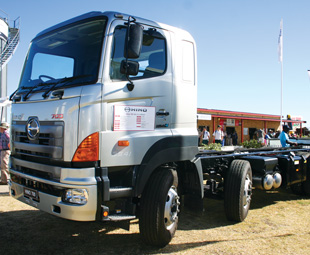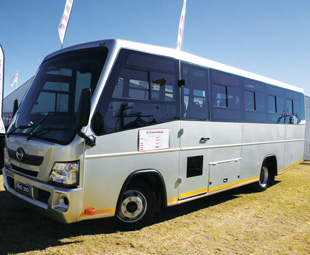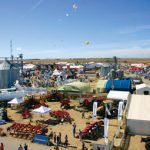HINO harvests customers!

A visit to the Hino stand at Nampo proved that this truck supplier is an integral part of the farming community. CHARLEEN CLARKE joined the fun (and committed a terrible crime along the way) …
I have a confession to make. It’s a terrible thing. But, fear not, it doesn’t involve dead bodies. However it does involve a serious crime.
The scene of the crime was the Hino stand at Nampo. At around 06:00 it was cold; very, very cold. The cold made me do it (not the devil; remember Hansie?) Anyway, in the bitter cold, I snuck onto the Hino stand. I had a steaming mug of coffee. And a rusk. Actually, we had four mugs in total. And four rusks. All stolen. (I was with the producer of our television show, called FOCUS on Nampo; he was party to the crime.)
Our producer was quite nervous about committing this dastardly deed. He is, after all, a timid bloke. But I explained the situation to him very clearly: “The Hino people are so nice. They won’t mind if we rob them. Honest!” (Shame, the poor chap still gulped down that coffee; I swear he scalded his throat … he was so desperate to escape.)
 Now I know exactly what you’re thinking: why is the daft FOCUS editor confessing her crime (there is a lesson to be learnt here, Mr P)? It’s because our crime was, in part, due to the Hino culture. I just knew that the Hino team wouldn’t mind … they are, after all, such a friendly and accommodating bunch of people.
Now I know exactly what you’re thinking: why is the daft FOCUS editor confessing her crime (there is a lesson to be learnt here, Mr P)? It’s because our crime was, in part, due to the Hino culture. I just knew that the Hino team wouldn’t mind … they are, after all, such a friendly and accommodating bunch of people.
Nampo is, after all, Hino’s second home – so visiting (and robbing; blush) the stand was a bit like visiting a cousin. In fact, the company has been harvesting customers at this show for years. “That’s because we’re mindful of the fact that Toyota’s foundations began with a major focus on light commercial vehicles, including their use by the farming community. It was for this reason that Toyota’s initial dealer network included many outlets in rural areas,” reveals Sameera Khan, marketing manager at Hino SA.
“Hino continues to have a massive dealer network in all areas of our country, and we’re expanding all the time. We have recently grown from 52 to 62 dealers,” adds Khan.
One of the reasons for the company’s growth is its warm, caring attitude. This goes down well – particularly in down-to-earth farming communities.
Another is its product range, which was in full force on the Hino stand at Nampo. We will kick off with probably the most interesting exhibit, in that it was unexpected: the Hino 300 bus. “Yes, it’s an unusual vehicle to see at Nampo. But it is popular with schools as well as local tourist organisations in the area. In the future we believe that farmers will buy these vehicles to transport their staff,” says Khan, adding that the bus can be customised according to customers’ needs.
Next up was the Hino 2848 truck tractor. “This is a very important model within our 700 range and it’s proving extremely popular with farmers because it really is ideal for long-haul distribution. The farmers like to hook it up to an interlink to transport mielies to the silo, and they can also use it to transport cattle. They have given the 353 kW engine the thumbs up too; it is testament to the durability of our products,” she notes.
 This truck tractor has a gross combined mass (GCM) of 65 000 kg, a double sleeper cab and the option of air or steel suspension, while the ZF AS Tronic transmission is standard. The new Hino 700-Series is fitted with a Euro-4 engine that is more economical to operate, with lower exhaust emissions.
This truck tractor has a gross combined mass (GCM) of 65 000 kg, a double sleeper cab and the option of air or steel suspension, while the ZF AS Tronic transmission is standard. The new Hino 700-Series is fitted with a Euro-4 engine that is more economical to operate, with lower exhaust emissions.
Also on display was the Hino 500 2626 6×2 freight carrier, with a 26-tonne gross vehicle mass (GVM), full-floating cab, ABS brakes and full dual air suspension on the rear. “This vehicle also has a Euro-4 engine and air suspension. It offers up to 14-tonne payload on a dropside or a cattle transporter. Plus it has a radio and air-conditioning for added driver comfort and convenience,” says Khan.
According to Khan, the 500 range is important within the agricultural market. “The 1626 and 1726 derivatives are especially popular. It’s perhaps interesting to note that the farmers tend to keep their trucks longer than their expected life cycle as they are used seasonally during their harvesting times,” she reveals.
Yet another vehicle, that caught the eye of the farmers, was the new Hino 700 3541 8×4. “We are the first out of all the Japanese brands to have an 8×4. This gives us a good footing in the growing construction industry. There are three different chassis configurations for this 8×4 which allows for freight carrier, tipper and mixer bodies to be fitted, thus enabling many different applications across industries,” says Khan.
The final star on the Hino stand was the Hino 300 915 long wheelbase. “This 300 range is our bread and butter and we are leaders in this segment. We are also pleased at our success at Truck Test 2014,” Khan reveals proudly.
She says that this vehicle has numerous applications. “It can be used for bakery products, agricultural products, grain … depending on your load weight and how this is then packed. It is the perfect vehicle for regional deliveries. In terms of productivity, fuel consumption and payload, we are delighted that this truck proved best in its class,” she points out.
Jors van der Linde, sales executive at Hino East Rand, notes: “Farmers want greater efficiencies. They keep their trucks for 15 to 20 years. A truck is a long-term investment, so quality, durability and reliability are very important,” he tells FOCUS.
He says that the agricultural market is growing. “This is thanks to all the new technology that we’re seeing. All the new farm implements have tracking systems on them. Farmers now know exactly how many tonnes per hectare are being planted and harvested. So farming has become more scientific,” he explains.
Because the barriers to entry are high, many of the farms remain in the hands of family members. “It’s extremely expensive to start from scratch, so there are a lot of family businesses within the farming sector,” confirms Van der Linde.
Families doing business with the friendly Hino family. It makes sense – doesn’t it?
Published by
Focus on Transport
focusmagsa




